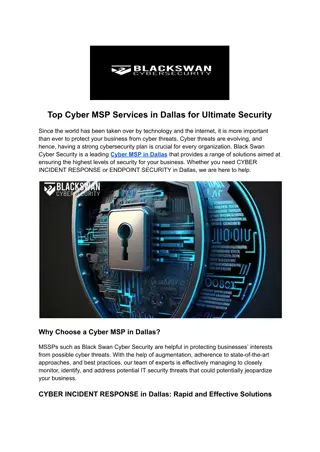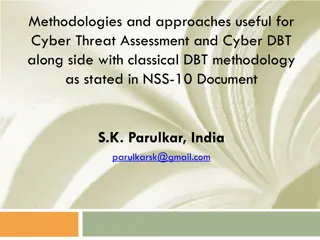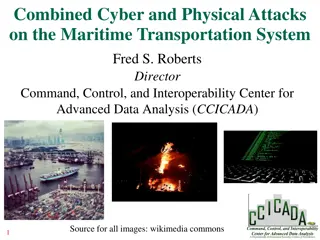Effective Countermeasures Against Cyber Attacks
Explore various defense mechanisms to prevent cyber attacks, including proper bounds checking, system defenses like NX bit, Canaries, ASLR, DEP, and techniques like ROP chains. Learn about compiler-level techniques such as inserting canaries on the stack to detect overflows and separating executable memory locations from writable ones.
Download Presentation

Please find below an Image/Link to download the presentation.
The content on the website is provided AS IS for your information and personal use only. It may not be sold, licensed, or shared on other websites without obtaining consent from the author. Download presentation by click this link. If you encounter any issues during the download, it is possible that the publisher has removed the file from their server.
E N D
Presentation Transcript
Part III Counter measures
HOW DO WE STOP THE ATTACKS? The best defense is proper bounds checking but there are many C/C++ programmers and some are bound to forget Are there any system defenses that can help?
HOW DO WE STOP THE ATTACKS? A variety of tricks in combination NX bit Canaries ASLR fin
III.A Canaries
Compiler-level techniques Canaries Goal: make sure we detect overflow of return address The functions' prologues insert a canary on the stack The canary is a 32-bit value inserted between the return address and local variables Types of canaries: 1. Terminator 2. Random 3. Random XOR The epilogue checks if the canary has been altered Drawback: requires recompilation
How good are they? Assume random canaries protect the stack
III.B DEP
DEP / NX bit / WX Idea: separate executable memory locations from writable ones A memory page cannot be both writable and executable at the same time Data Execution Prevention (DEP)
Bypassing WX Return into libc Three assumptions: We can manipulate a code pointer The stack is writable We know the address of a suitable" library function (e.g., system())
arg 0xbfffeee8 arg 0xbfffeee4 Stack ret address 0xbfffeee0 0x08048430 System() 0xbfffeedc 0xbfffeed8 Why the ret address ? What could we do with it? 0xbfffeed4 0xbfffeed0 0xbfffeecc 0xbfffeec8 buf 0xbfffeec4 0xbfffeec0 0xbfffeebc 0xbfffeeb8 0xbfffeeb4 0xbfffeeb0 0xbfffeeac 0xbfffeea8 0xbfffeea4
Return Oriented Programming ROP chains: Small snippets of code ending with a RET Can be chained together
Return Oriented Programming ROP chains Small snippets of code ending with a RET Can be chained together -- ret ret &gadget3 &gadget2 &gadget1 stack
How good are they? Assume random canaries protect the stack Assume DEP prevents execution of the stack
III.C ASLR
Address Space Layout Randomisation Idea: Re-arrange the position of key data areas randomly (stack, .data, .text, shared libraries, . . . ) Buffer overflow: the attacker does not know the address of the shellcode Return-into-libc: the attacker can't predict the address of the library function Implementations: Linux kernel > 2.6.11, Windows Vista, . . .
ASLR: Problems 32-bit implementations use few randomisation bits An attacker can still exploit non-randomised areas, or rely on other information leaks (e.g., format bug) So (I bet you saw this one coming) .
How good are they? Assume random canaries protect the stack Assume DEP prevents execution of the stack Assume ASLR randomized the stack and the start address of the code but let us assume that all functions are still at the same relative offset from start address of code (in other words: need only a single code pointer)
We constructed weird machines New spin on fundamental questions: What is computable? Shellcode, ROP, Ret2Libc Turing Complete
That is all folks! We have covered quite a lot: Simple buffer overflows Counter measures Counter counter measures Research suggests that buffer overflows will be with us for quite some time Best avoid them in your code!























